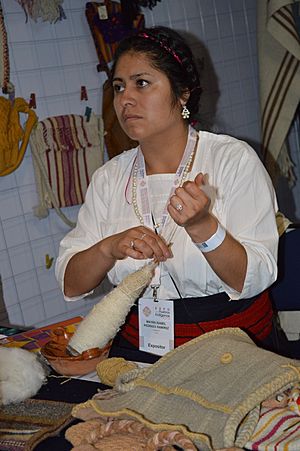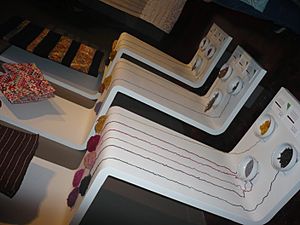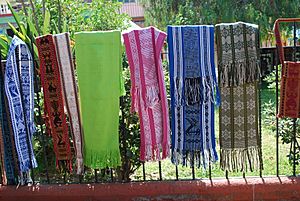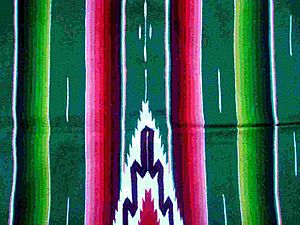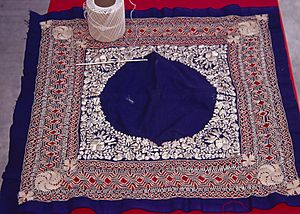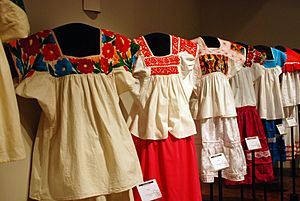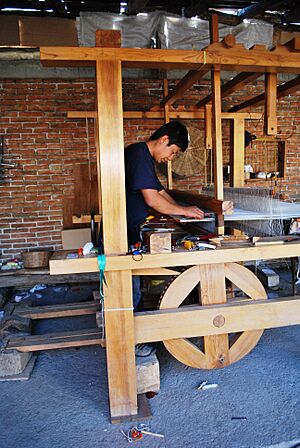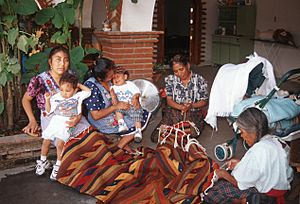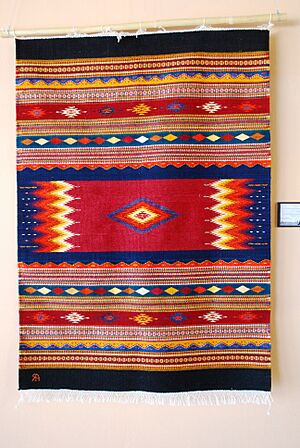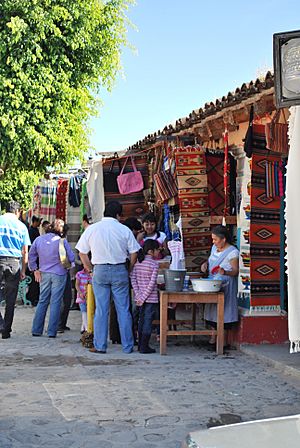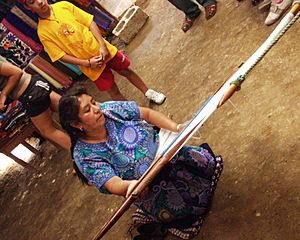Textiles of Mexico facts for kids
The textiles of Mexico have a very long and interesting history! People in Mexico have been making fabrics, clothes, and other textile items since at least 1400 BCE. Long ago, they used natural fibers from plants like yucca, palm, and maguey. In warmer areas, they also grew cotton.
When the Spanish arrived, they brought new materials like silk and wool. They also introduced a new type of loom that used foot pedals. This changed how clothes were made and what they looked like. For a long time, fabric was made by hand in homes or small workshops. But in the late 1800s, machines started to be used for weaving.
Today, textiles are still made by hand by skilled craftspeople, and also in large factories. Handcrafted items include traditional clothing like huipils (tunics) and sarapes (shawls), which often have beautiful embroidery. Many of these items are made by indigenous people in states like Mexico State, Oaxaca, and Chiapas. They often use natural fibers and dyes from plants and insects.
The textile industry is still important for Mexico's economy. However, it faces challenges because cheaper goods are made in countries like China and India.
Contents
History of Mexican Textiles
Ancient Times (Before the Spanish Arrived)
The oldest pieces of fabric found in Mexico are from about 1800 to 1400 BCE. They were discovered in the dry northern parts of the country. In ancient times, people in dry areas used fibers from yucca and palm trees. In warmer, wetter areas, they grew cotton.
The Aztecs didn't know about cotton until they conquered areas where it grew. Then, they demanded cotton as a payment. Only the upper classes were allowed to wear cotton clothing. Cotton cloth was so important that it was sometimes even used as money!
Many ancient cultures in Mexico had a god or goddess of weaving. Women were often buried with the beautiful woven items they had made. Even the Spanish explorer Cortés wrote about how skilled the Aztecs were at weaving.
Colonial Period (After the Spanish Arrived)
After the Spanish conquered the Aztec Empire, textile making changed a lot. The Spanish didn't like many of the traditional clothes and body decorations, calling them "uncivilized."
New materials and techniques were introduced. The Spanish brought sheep for wool and silkworms for silk. By the late 1530s, they also brought European foot pedal looms. By 1580, Mexico became a major producer of wool and silk cloth. Most of this was made in places like Oaxaca, Tlaxcala, and Puebla.
At first, Spanish weavers made most of the cloth. But soon, native weavers took over because they could make fabric more cheaply. Instead of stopping them, the Spanish hired indigenous weavers to work in workshops. These workshops made enough fabric for Mexico and even for export to Spain, the Philippines, and other countries.
Silk production was very big from 1540 to 1580. But then, ships from Asia started bringing cheaper silk, which made Mexican silk less popular. Cotton and wool fabric then became even more important. Wool was popular with the upper classes, and sheep could be raised near weaving areas.
From the 1800s to Today
In the past, clothes and fabrics were made to last for many years. But today, fabric is much cheaper, and clothes are often thrown away sooner. This is mainly because machines now do much of the weaving.
In the 1800s, new machines powered by steam arrived in Mexico, mostly brought by French immigrants. This led to the mass production of textiles, especially cotton. By the late 1800s, textile making was the biggest manufacturing business in Mexico. French immigrants controlled much of it, starting small mills that grew into large factories and department stores.
In the early 1900s, the sewing machine became popular. This made it easier to join fabrics and add embroidery, leading to the creation of finished clothing.
Handcrafted and Indigenous Textiles Today
Traditional Ways of Making Textiles
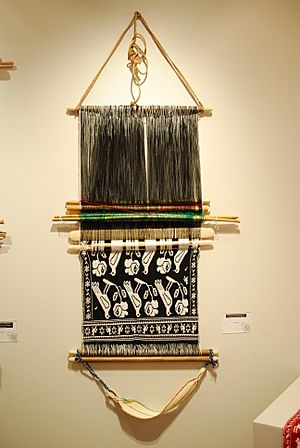
Textiles are one of Mexico's most important crafts. They show how old traditions continue and mix with new designs. Both ancient and colonial styles of textiles are still made. Many textile factories even use machines based on the old foot pedal looms.
There are four main types of fibers used:
- Plants: like cotton
- Animals: like wool and silk
- Minerals: like gold and silver thread
- Synthetics: man-made fibers
In indigenous communities, women often make the clothes for their families. This can involve harvesting natural fibers, then spinning them into thread, dyeing them, and finally weaving. Both the ancient backstrap looms and the European pedal looms are used, mainly for cotton and wool.
Most handcrafted textiles are made by Mexico's many indigenous groups, who live mostly in rural areas in the center and south of the country. Their textiles often have traditional designs and techniques. One common technique is brocade, which creates raised patterns in the fabric. These textiles are used for clothing, home items, decoration, and ceremonies. Clothing is a way for these groups to show their unique identity.
Some traditional garments include the huipil, the quechquemitl, and rebozos. Some groups, like the Nahuas in central Mexico, sell their traditional creations. People in coastal areas still grow cotton and dye it with natural materials like indigo.
Traditional Clothing
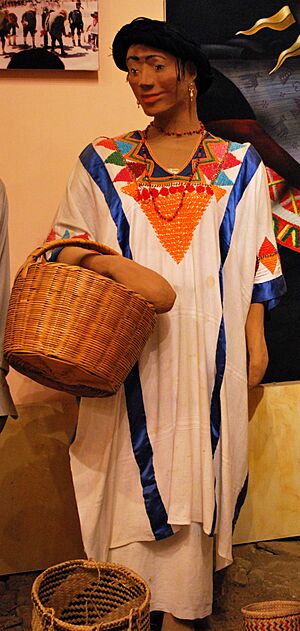
Most of the ancient clothing that still exists is for women. This includes "enredos" (wrap dresses), "fajas" (cloth belts), huipils (tunic-like dresses), and quechquemitl (a short poncho). Huipils are often heavily embroidered with flowers and geometric shapes.
A very popular item for both indigenous and mixed-race communities is the rebozo. This is a long, rectangular shawl used as a wrap or to carry children or heavy items. The rebozo developed during the colonial period, mixing ancient Mexican, Spanish, and Asian influences. Rebozos have long fringes at the ends. Many have colorful designs woven into them. Some are tie-dyed to create color variations, a style called "jaspe."
Rebozos have been made in central Mexico since colonial times. Tenancingo is famous for its craft rebozos, usually made of cotton or wool.
Few ancient male clothing pieces survived because many men in Mesoamerica wore little clothing. The Spanish made them wear European-style shirts and pants. These early colonial styles have changed little in indigenous communities and are now seen as traditional. Many male garments are brightly embroidered. Since traditional pants don't have pockets, many men carry decorated bags called morrals. The only ancient male garment that still exists is the sarape, used in certain areas of Mexico.
Besides clothing, other items like bedspreads, blankets, hats, and knapsacks are woven. Their designs are often woven into the fabric or embroidered with stars, animals, and other patterns.
Embroidery
Embroidery is a special part of indigenous handcrafted textiles. The patterns on garments include geometric shapes like zig-zags, spirals, moons, crosses, and stepped patterns. Thin cloth belts (fajillas) are often richly embroidered. The Huichols use zig-zag edges, while the Otomis use moon patterns. The Tarahumara decorate theirs with triangles.
Flower designs are popular for women's clothing among the Otomis, Nahuas, Huastecs, Huichols, and others. Spirals and curved designs are common in central and southern Mexico.
Besides flowers, other nature themes in woven and embroidered designs include plants and animals like squirrels, rabbits, deer, armadillos, doves, hummingbirds, and fish. Mazahua belts are known for animal designs, and those from Santo Tomás Jalieza often show large feathered birds.
Human figures also appear, for example, on embroidered napkins from San Juan Colorado. Patriotic symbols like two-headed eagles and the Mexican flag's eagle crest are common in central Mexico.
Christian symbols like the cross, virgins, saints, and angels were brought by missionaries long ago. They appear on items like men's shirts among the Tzotzil people in Chiapas, and the Virgin of Guadalupe appears in many textiles in Puebla.
Popular sayings or phrases also appear, especially in textiles from the Purépecha people around Lake Pátzcuaro.
Looms Used for Weaving
Two main types of looms are used for handcrafted fabrics: the ancient backstrap loom and the European foot pedal loom. Traditionally, weaving on the backstrap loom was women's work. Women still make items like kitchen cloths, tablecloths, and bags with traditional designs. The backstrap loom is simple but can create very complex designs. It's common in southern Mexico.
The foot pedal loom came to Mexico after the Spanish Conquest. Men traditionally use this loom, often with wool. This loom is used more in central and northern Mexico. Its main advantage is that it can make wider pieces of fabric than the backstrap loom, like sarapes, rugs, and blankets.
Rugs and Other Items from Oaxaca and Mexico State
Oaxaca and Mexico State are known for their handcrafted textiles. Oaxaca is famous for rugs, rebozos, tablecloths, and traditional clothing like huipils. These are made on both backstrap and foot pedal looms. In Mexico State, crafts are made in places like Jiquipilco and Tenancingo, including napkins, tablecloths, clothing, and rugs.
Both states also produce many rugs. The Otomi people in Mexico State started making knotted rugs in 1969. These rugs are now a special part of Mexico State crafts. They are made with 100% wool and have many different designs and colors.
Teotitlán del Valle in Oaxaca is famous for its woven rugs. Most weavers there use foot pedal looms and wool dyed with natural materials like indigo and the cochineal bug. The cochineal insect has been used since ancient times to dye fiber, creating colors from purple to yellow. For a while, cheaper synthetic dyes were popular, but natural dyes have made a comeback.
Protecting Handcrafted Textiles
After the Mexican Revolution, traditional Mexican cultures became very popular, including arts, crafts, food, and regional clothing. Artists like Diego Rivera helped show this.
Since then, many efforts have been made to keep textile traditions alive, especially in southern Mexico. The Textile Museum in Oaxaca has a collection of 4,000 pieces, including modern, colonial, and ancient textiles.
Sna' Jolobil, which means "House of the Textiles" in the Tzotzil language, is a group of over 600 Tzotzil and Tzeltal women in Chiapas. They work to promote textile crafts, especially those made on backstrap looms. Their goal is to save traditional techniques and designs and help women weavers earn money. They have old huipils for study and offer workshops on weaving and natural dyes.
Government agencies also promote textiles through contests and by recognizing master craftspeople. For example, Florentina López de Jesús is an Amusgo weaver from Guerrero. She learned to weave at age six and is known for using "coyochi" (brown cotton). Her work has won many awards.
Juan Rayón Salinas from Mexico State learned European rug-making techniques and now has his own workshop. Reyna Rayón Salinas, also from Xonacatlán, is known for her cloth belts and embroidery. Cosme Flores from Tlaxcala is a weaver who has won prizes for his wool rugs. Justina Oviedo Rangel from Oaxaca weaves napkins and tablecloths and has won awards since she was young.
Evaristo Borboa from Tenancingo, Mexico State, is famous for making rebozos on a backstrap loom, one at a time. He is also known for his "ikat" or "jasper" style, where threads are tie-dyed before weaving.
Handcrafted textiles are also a big draw for tourists, especially in Chiapas. People are becoming more interested in locally made items, and Mexican handcrafted textiles are even being used by famous global brands.
However, these traditional textiles face challenges. Countries like China and Guatemala are making copies of traditional Mexican indigenous designs. These copies are sold both inside and outside Mexico. Organizations are working to protect indigenous designs as "intangible world heritage" to ensure their authenticity, much like tequila or Talavera pottery.
The Modern Textile Industry
Importance of the Textile Industry Today
Modern textile production in Mexico started in the late 1800s. Today, it's a very important part of Mexico's economy. It creates jobs and products for export. The industry makes thread, cloth, and decorations using both natural and man-made fibers. It makes up about 1.2% of Mexico's total economy and 7.1% of its manufacturing sector. It's the fourth largest manufacturing activity in the country.
For many years, the textile industry grew steadily. A lot of this growth came from "maquiladoras," which are factories along the northern border. These factories can import raw materials without taxes to make products for export.
Guanajuato is another important textile area, being Mexico's third largest producer. They make clothing like jeans, blouses, and t-shirts for both Mexican and international brands.
However, since the mid-2000s, the industry has faced problems, mainly due to competition from other countries. Many jobs and factories have been lost as production moves to Asia.
Selling Textiles to Other Countries
The United States buys the most textiles in the world, and many countries want to sell their products there. Mexico is the fourth largest exporter of textiles to the U.S. Mexico has advantages because it's close to the U.S. and has good trade agreements, like NAFTA. In 2004, all limits on Mexican textiles entering the U.S. were removed.
However, Mexico's textile exports to the U.S. have dropped because the U.S. imports more from countries that produce goods more cheaply. For example, U.S. imports of Chinese garments grew a lot, while Mexican ones decreased. This is partly because taxes on imports from other countries have also been lowered.
Other Markets Around the World
While the U.S. is the biggest market, Mexico has free-trade agreements with 43 countries. Recently, Mexico and Peru made a deal for clothing and textile trade. Mexico's textile exports to Canada also increased a lot in the mid-2000s.
Selling Clothes in Mexico
In Mexico, about 40% of clothing sales happen in major chain stores. But a large part of the clothing market (about 58%) gets its goods through illegal ways, like smuggling or avoiding taxes. Much of the illegal Chinese textiles sold in Mexico come through the United States, where labels are changed to avoid Mexico's high taxes on Chinese goods.
Who Mexico Competes With
Mexican textile exports compete with products from China, India, Bangladesh, Pakistan, Indonesia, Vietnam, Hong Kong, and Central America. In 2000, Mexican textiles had about 12% of the U.S. market, while Indian textiles had 3.84%.
One big reason for this competition is that labor costs (what workers are paid) are much higher in Mexico than in Asia. Also, Mexico has rules that can make it harder for businesses to invest, and stricter environmental laws. For example, Mexican fabrics cost more per square meter than Chinese textiles.
China is Mexico's biggest competitor. Not only are Chinese products cheaper, but their supply chain (how products are made and delivered) is more organized. For example, most threads used to sew clothes are made in China, while Mexico has to import them, which can cause delays. Mexico also mostly makes basic items, not more fashionable products that sell for more money.
Mexico has even complained to the World Trade Organization that China is using "illegal practices" like "dumping" (selling goods abroad at a lower price than at home) to hurt the Mexican industry. Mexico claims the Chinese government helps its textile companies sell abroad to gain market share.




